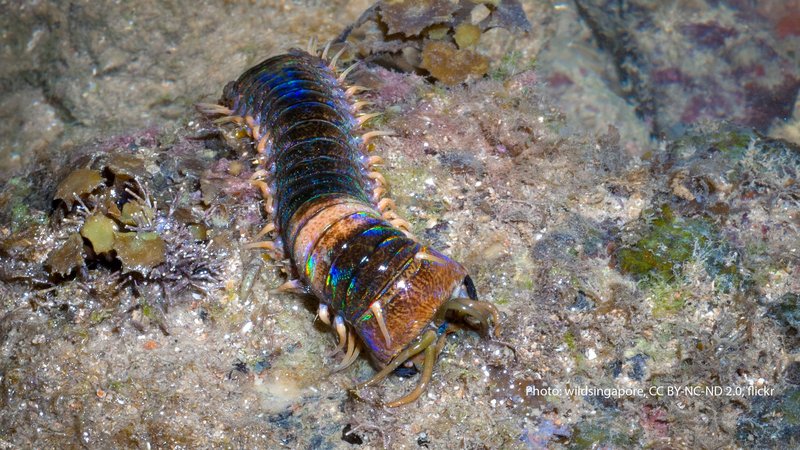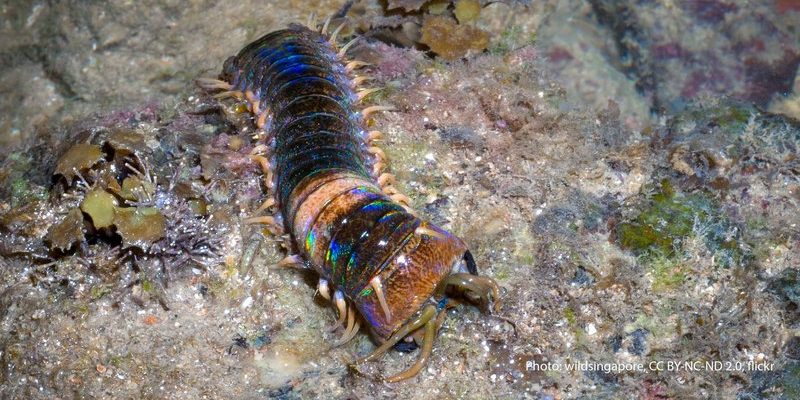
Imagine a creature that’s part worm and part ambush predator, living in sandy burrows along the ocean floor and waiting for the right moment to strike. That’s the bobbit worm for you. Their unique adaptations not only help them capture prey efficiently but also allow them to thrive in their diverse marine environments. So, let’s dive deeper into the evolutionary traits that make bobbit worms such effective hunters.
1. The Art of Camouflage
Bobbit worms are the masters of disguise. These creatures often bury themselves deep in the ocean floor, leaving only their colorful, segmented bodies exposed. This ability to blend in with their surroundings is a crucial element of their hunting strategy. The bright colors and intricate patterns of their bodies mimic the textures of the rocks, coral, and sand around them.
This camouflage serves two purposes. First, it helps them avoid predators that might be looking for a meal. Second, it enhances their hunting capabilities by allowing them to ambush unsuspecting prey. Imagine being a fish swimming along, only to be snatched up by a worm that seemed to blend seamlessly into its environment! The element of surprise is a key factor in the bobbit worm’s success.
2. Lightning-Fast Strike
You might be wondering how a worm can be an effective hunter when it doesn’t have the speed of a shark or the agility of an octopus. Well, bobbit worms have evolved a unique adaptation for this—their incredible striking speed. When they sense potential prey passing by, they can extend their powerful, jaw-like appendages at lightning speed. It’s almost like watching a snake strike in the blink of an eye!
These appendages, armed with sharp mandibles, grab hold of fish, crustaceans, or any unsuspecting victims. This means that once an animal brushes too close to their hidden lair, it’s often too late to escape. The bobbit worm’s ability to launch such a swift attack is a testament to their evolutionary prowess.
3. Powerful Mandibles for Grabbing Prey
Let’s talk a bit more about those mandibles. They’re not only fast but also incredibly powerful. The jaw-like structures of a bobbit worm can crush the exoskeletons of crustaceans or pierce the flesh of fish. This means that once they’ve caught their prey, they’ve got the upper hand—quite literally!
Their mandibles are like the ultimate Swiss Army knife of the ocean. They can execute precise moves, allowing the worm to hold onto its victim tightly while it moves back into its burrow. This combination of speed and power makes bobbit worms a significant threat to many marine animals. They truly embody the saying, “Don’t judge a book by its cover.” Just because they look like a humble worm doesn’t mean they’re not a fierce predator!
4. Sense of Smell
Bobbit worms also have an impressive sense of smell, which helps them locate prey from a distance. They can detect tiny chemical signals released by fish and other animals with their sophisticated sensory structures. This ability is akin to having a radar system that alerts them to potential meals nearby.
Once they catch wind of some tasty prey, they can quickly spring into action. Coupled with their camouflage and striking speed, their acute sense of smell makes them highly effective hunters. Imagine having a superpower that tells you when dinner is nearby. That’s basically what bobbit worms experience every day!
5. Adaptation to Different Environments
Another fascinating trait of bobbit worms is their adaptability to various marine environments. They can thrive in both shallow waters and deeper oceanic regions. This flexibility allows them to hunt a wide range of prey and adjust to changing conditions. Some species of bobbit worms prefer to inhabit coral reefs, while others find their homes in muddy or sandy bottoms.
This adaptability isn’t just beneficial for hunting; it also helps them avoid predators and find suitable mates. Think about it: if you can live in multiple habitats, you’re less likely to encounter the same threats. This ability to adjust to different places and conditions is a significant factor in their evolutionary success.
6. Reproductive Strategies
While we often think of hunting as a solitary activity, reproduction is also a key part of survival for bobbit worms. They have fascinating reproductive strategies that ensure their survival in the long run. Many species of bobbit worms can reproduce both sexually and asexually, allowing them to adapt to their environments flexibly.
In some species, a single worm can release eggs that develop into larvae. These larvae then drift in the ocean, eventually settling in new locations to grow into adult worms. This strategy allows for genetic variation and increases the chances that some offspring will find a suitable habitat for hunting and living.
7. Speed of Growth and Longevity
Finally, let’s touch on growth rates and longevity. Bobbit worms can grow quite quickly, often reaching impressive lengths of up to 10 feet! This rapid growth allows them to become effective hunters in a relatively short time. Once they’ve grown, they can live for many years, continuing to refine their hunting techniques and reproduce.
This combination of speed in growth and long life ensures that bobbit worms maintain their position as dominant predators in their habitats. Once they reach maturity, they can keep hunting and producing offspring, which helps stabilize their populations.
Bobbit worms are truly remarkable creatures, embodying a unique set of evolutionary traits that make them efficient hunters. From their camouflage and lightning-fast strikes to their powerful mandibles and keen sense of smell, these worms are well-adapted to thrive in their underwater environments. Their ability to adapt to different habitats, along with diverse reproductive strategies, ensures their success as a species.
Next time you’re near the ocean, take a moment to appreciate the incredible adaptations of creatures like the bobbit worm. They may look unassuming, but beneath the surface lies a world of complexity and efficiency that showcases nature’s ingenuity.

